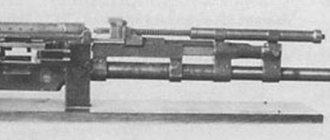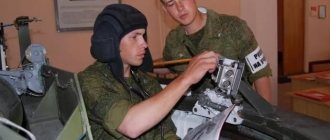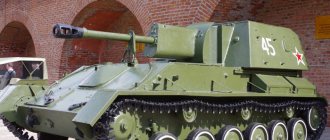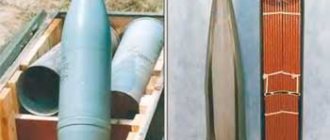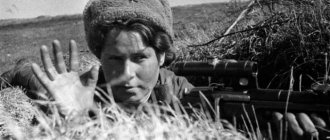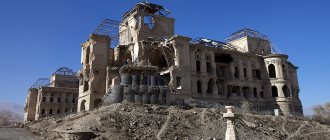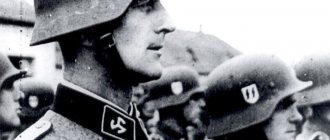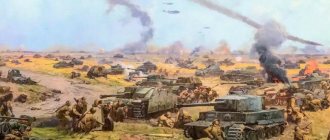Evgeny Guryev Heritage October 02, 2019
Let me express my gratitude to Associate Professor of St. Petersburg State University of Civil Engineering Evgeniy Guryev for a thorough study of the sources on the Prokhorovsky battle. I diligently collect all issues of the “History” strip, and I find the one named above worthy of publication in special scientific journals on military history. In the summer series of my radio scripts on “Radio Russia - St. Petersburg” called “Memory Watch”, I dedicated one of the programs to a story about the battle of Prokhorovka - in particular, about the role of the 5th Tank Army of Colonel General P. A. Rotmistrov. And I was glad to see scientific confirmation of my broadcasted assessments - both the battle of Prokhorovka and the almost decisive role of P. A. Rotmistrov and his army, which suffered horrific losses. Evgeny Guryev did not mention only an essential detail, which explains, among other things, the scale of our losses: the fascist tanks were equipped with radio communications, ours were not. Perhaps it should have been more clearly reported that our tanks (namely tanks, not self-propelled guns) were then significantly behind the enemy’s in technical equipment: P. A. Rotmistrov reported this to the Deputy People’s Commissar of Defense of the USSR G. K. at a good engineering level. Zhukov in a report dated August 20, 1943. Our State Defense Committee, in which G.M. Malenkov, L.P. Beria and N.A. Voznesensky were responsible for the production of weapons, “slept through” the build-up of the technical superiority of German tanks over our T-34s, which at the very beginning of the war were truly superior to Wehrmacht tanks. Is this why P.A. Rotmistrov, who found himself in the role of the last “last man” who did not allow the enemy to break through our defenses, was not punished, and soon, in 1944, became the first marshal of the armored forces? In general, the military biography of P. A. Rotmistrov deserves interested attention. I will only point out that he was recalled by Headquarters from the front during the days of the battle for Vilnius in the summer of 1944 at the insistence of the commander of the 3rd Belorussian Front, I. D. Chernyakhovsky, but was not punished, but was immediately appointed to a prominent position in Moscow... Georgy VASYUTOCHKIN
Photo: Wikimedia Commons / Dmitry A, Mottl / Creative Commons Attribution-Share Alike 3.0 Unported
The editors forwarded the question in the letter to Evgeny GURIEV and asked him to return to the topic under discussion.
— Indeed, one of the reasons for the high losses of Soviet armored vehicles in the Battle of Kursk and, in particular, near Prokhorovka was the technical superiority of German tanks in armament and armor.
At the beginning of the war, new types of Soviet combat vehicles - the heavy KV-1 and medium T-34 - were superior in armament and protection to all German tanks and self-propelled artillery guns (SPG). Already from the first battles of the summer of 1941, German reports spoke of the invulnerability of the new Russian tanks, which the armored vehicles and anti-tank guns of the Wehrmacht could not fight.
Thus, the best German medium tank Pz-IV F was armed with a 75-mm short-barreled cannon with a barrel length of only 24 calibers, with an initial armor-piercing projectile speed of 385 m/s. And the thickness of the frontal armor of its hull was 50 mm. The StuG-III E assault gun had similar armament and protection characteristics.
For comparison: the Soviet T-34 tank of the 1940 model was armed with a 76.2-mm L-11 cannon with a barrel length of 30 calibers, the muzzle velocity of the projectile was 668 m/s, and the thickness of the frontal armor was 45 mm, and it was located at an angle to the vertical, which increased its reflective abilities.
The KV-1 heavy tank was even stronger: it was armed with a cannon with a 41-caliber barrel and had more powerful armor (the front of the hull was 75 mm).
The reasons for the defeats of the Soviet tank forces at the beginning of the war were not the technical superiority of German tanks, as was often written in Soviet times, but the unreliability of equipment, poor training of crews, command errors, air superiority of German aviation and the general unsuccessful course of the war for the Red Army (retreat, battles surrounded, etc.).
Related article:
A battle without winners. True facts about the battle of Prokhorovka in 1943
The German command, despite the successful course of military operations for itself, set before its defense industry the task of strengthening the armament of existing tanks and developing heavy vehicles and self-propelled guns of new types specifically to combat the Soviet T-34 and KV-1. It was successfully resolved by the summer of 1942: it was then that the superiority in tank armament began to change in favor of the Germans.
By the following summer, the balance of power had shifted even further. New heavy tanks and self-propelled guns of the Wehrmacht could hit Soviet ones with impunity from a distance of 1.5 - 2 km, while those - from a distance of 0.5 - 1 km.
It was the heavy losses of Soviet armored vehicles during the Battle of Kursk that became the reason for the creation of the G. M. Malenkov commission. As a result of its work, the development and production of new types of Soviet tanks, which went into battle already at the beginning of 1944, were accelerated. And, for example, the IS-2 heavy tank, armed with a 122-mm gun with a barrel length of 48 calibers and protected by 120-mm sloping frontal armor, could successfully hit all types of German tanks, including the Tiger.
As for the biography of Pavel Alekseevich Rotmistrov, it, like the biographies of most Soviet military leaders, requires detailed and non-opportunistic research. The path to the formation of Soviet tank forces during the Great Patriotic War was too long, difficult and bloody to unambiguously evaluate the combat biographies of their commanders.
Yes, P. A. Rotmistrov had failures, there was discontent among both his subordinates and his superiors, but there were also successful actions and well-deserved high awards. In the Battle of Prokhorovka, tankers of the 5th Guards Tank Army, despite losses, completed their task and stopped the breakthrough of German tanks. In the battle of Korsun-Shevchenkovsky in February 1944, they closed the encirclement of the German group (for which P. A. Rotmistrov was promoted to marshal of the armored forces), and in the Belarusian operation in the summer of 1944, it was P. A. Rotmistrov’s tankers who were the first to break into Mogilev , Minsk and Vilnius.
The failures of P. A. Rotmistrov near Moscow and Voronezh are explained more by poor preparation of the offensive than by the commander’s mistakes, high losses at Prokhorovka - an oncoming tank battle and the superiority of the Germans in weapons.
In the end, all memoirists note the quarrelsome character of Pavel Alekseevich, so one can assume that he simply did not work well with I. D. Chernyakhovsky. Appointed to the post of deputy commander of the armored forces, P. A. Rotmistrov did not participate in the battles of the end of the war, which brought well-deserved laurels and stars to his colleagues M. E. Katukov, S. I. Bogdanov, P. S. Rybalko and D. D. Lelyushenko, although his merits were appreciated in the 1960s by awarding the titles of Hero of the Soviet Union and Chief Marshal of the Armored Forces.
#Great Patriotic War #history of Russia #tanks
The material was published in the newspaper “St. Petersburg Vedomosti” No. 184 (6537) dated 10/02/2019.
Share on VKontakte Facebook
Cool
Section materials
January 19, 10:29
Live always, Leningrad! St. Petersburg remembers the days of the siege
January 05, 09:00
No reinforcements arrived. Heroism and tragedy of the Evpatoria naval landing
December 01, 10:40
Marshal of Victory. Georgy Zhukov
November 29, 10:18
Captured while performing a combat mission. Red Army soldier Kosmodemyanskaya
November 23, 11:41
The remains of more than 2.5 thousand Red Army soldiers were discovered in the Leningrad region
Pages of history
ARMORED VEHICLES OF THE USSR AS OF 06/22/41:
1)
https://www.politforums.ru/historypages/13398743... + The USSR has 20.5 thousand serviceable tanks
(superior to German ones in classes) https://www.politforums.ru/historypages/13641217…
https://www.politforums.ru/historypages/13641217 ... armored tractor T-20 "Komsomolets" as of 06/22/41 = 6,672 units = faulty medium and major repairs 28% = this is 1840 units faulty = WHAT IT FOLLOWS THAT THE T- 20 UNDER 5 thousand pcs.
https://bronetehnika.narod.ru/t27/t27.html On January 1, 1941, the troops still had 2,157 T-27 tankettes, of which, by analogy, 1.6 pieces. are in good working order
,
tank (I’ll equate it to a wedge heel) T-18 = 160pcs
at the beginning of the Second World War https://ru.wikipedia.org/wiki/%D2-18
AND OF THE INDICATED serviceable WEDS = under 6.7 thousand + 20.5 thousand serviceable ones counted in the topic = 27.2 thousand. tracked serviceable armored vehicles
+ 6 thousand wheeled armored vehicles, 10% of which require medium and major repairs https://pro-tank.ru/component/content/article/12... = this is 5.4 thousand serviceable wheeled armored vehicles.
THE TOTAL OF SERVICEABLE ARMORED VEHICLES OF THE USSR AT THE BEGINNING OF WWII was 32.6 thousand. PC.
(serviceable: tracked 27.2 thousand pieces + wheeled 5.4 thousand pieces)
== WHEEL ARMORED VEHICLES at the beginning of the Second World War:
https://pro-tank.ru/component/content/article/12... Report of the head of the GABTU to the Main Military Council of the Spacecraft on the state of provision of armored vehicles and property to the Red Army June 1, 1941 Armored vehicles BA-20 (passenger car) 1899pcs
Armored vehicles BA-10
3361 pieces
Railway armored vehicles
light 108pcs
Armored railway vehicles medium
52pcs =THIS IS 5420pcs??.
Light and heavy armored trains 44pcs
https://ru.wikipedia.org/wiki/%C1%C0-%C8 BA-I (short for “Izhora Armored Car” AT 01/1/41 = 77 pcs.
(wheeled with 37mm cannon)
https://ru.mobile.wikipedia.org/wiki/FAI_(armored... By the beginning of the Great Patriotic War, there were 376 units
armored vehicles
FAI and FAI-M
https://www.aviarmor.net/tww2/armored_cars/ussr/... As of June 1, 1941, the Red Army continued to have 45 wheeled armored vehicles
D-12 designed by Dyrenkov (19 of them were under repair)
these are only 5915 wheeled armored cars at the beginning of the Second World War (including those with guns) ????
and taking into account the report of the Red Army https://pro-tank.ru/component/content/article/12...: “Among the total availability of armored vehicles as of June 1, 1941, there are 1,147 obsolete armored vehicles (BAI, FAI, etc.)
.
The BA-20 and BA-10 armored vehicles do not completely meet the modern requirements of the Red Army, as they have insufficient armor (6-10 mm) and low cross-country ability.” = it is obvious that there were at least 6,000 wheeled armored vehicles of the Red Army at the beginning of the Second World War
===================================== ==== MOTORCYCLES AT THE BEGINNING OF WWII
https://img-fotki.yandex.ru/get/4427/28036830.f2… https://img-fotki.yandex.ru/get/5607/fotosergs.b… availability of motorcycles in the Red Army as of 06/15/41 Motorcycles 16,918 pcs .
=================== ======================================== ==========
https://beloepyatno.blogspot.ru/search/label/-BR... ARMORED EQUIPMENT IN NUMBERS
- on June 22, 1941, on the Eastern Front against the USSR, the Wehrmacht concentrated (including the reserve of the High Command - the 2nd and 5th Panzer Divisions) 3580 tanks, and in North Africa - about 350 (Note 31 *) - German satellites: Hungary, Romania, Finland and Slovakia had 349 tanks on the borders with the USSR on June 22, 1941, which, together with 3963 German ones, amounted to 4312 tanks, self-propelled guns, assault guns and tank destroyers (Note 7*) - the Germans began military operations against the USSR with 55% light tanks and tank destroyers, 45% of medium tanks with an absolute absence of heavy tanks (Note 7*) - according to German data, by September 22, 1941, 14,049 Soviet tanks were destroyed or captured (Note 7* and 26*) - average monthly production of tanks and self-propelled guns of all types in Germany grew from 180 in 1940 to 240 in the first half of 1941 (Note 41*) - the number of tanks in a German tank division on average ranged from 324 units in the initial period of WW2 to 120-140 units at its final stage ( Note 31 *) - the maximum production of German tanks and self-propelled guns was at the end of 1944 - 1800 tanks per month, the maximum production of tanks was 865 tanks in August 1944 (Note 31 *) - the famous separate heavy tank battalions (10 - in the Wehrmacht and 3 in the SS troops) numbered from 35 to 55 Tiger tanks (Note 31*) - in just 11 years (1934-1945) Germany produced just over 50 thousand tanks (Note 31*) - monthly in the first half of 1941 Germany produced 270 tanks (Note 34*) - as of March 20, 1942, the Wehrmacht's armored personnel carrier losses amounted to: 3,319 tanks and 173 assault guns. Replenishment for the same period of time amounted to only 732 tanks and 17 assault guns (Note 40 *) - in total, almost 11 thousand T-26 tanks of more than 25 different modifications were produced (Note 6 *) - 150-mm self-propelled gun "Hummel" (“Bumblebee”) was produced in 1943–44. A total of 714 vehicles were produced. Its high-explosive projectile weighs 43.5 kg. hit targets at a distance of up to 13.3 km. (Note 31*) - from February 1943 to the end of the Second World War, 494 88-mm Nashorn (Rhinoceros) self-propelled guns were produced: in 43 - 345, in 44 - 133, in 45 - 16. As of 02/01/1945 there were 141 self-propelled guns, and on 04/10/1945 - only 85. For anti-tank warfare, its armor was insufficient, and the vehicle was too high (Note 40*) - 435 command tanks were produced on the basis of the German T-III tank, another 262 were converted from tanks into artillery fire control vehicles and 100 were converted into flamethrower tanks (Note 31*) - more than 400 T-34s of various modifications were transferred to the USSR to the Egyptian army and about 200 more tanks were in service with the Syrian army. The Egyptian-funded Lebanese group al-Marabitoun also had 12 tanks. About 300 T-34s were captured by Israel, to be subsequently mostly used as targets at training grounds - during July-August 1943, irrecoverable losses, according to German data, amounted to 73 Tigers, and by the end of the year - 271 tanks. In 1943, only 19 tanks of this type were able to return to service after repairs. In 1944, 644 “Tigers” were lost, of which only 60 were able to return to service (Note 36*) The German tank T-VIH “Tiger” became one of the most repair-unusable tanks of the Wehrmacht, often due to the fact that the amount of damage inflicted by the enemy for withdrawal This tank's failure in many ways exceeded the amount of damage for any other German WW2 tank (editor's note) - during the Second World War, 5915 T-60 tanks, 8226 T-70 tanks and 81 T-80 tanks were produced (Note 31*) - Germany in September 1939 had 3195 tanks, and by June 1941 - 5639 (of which 4300 were included in the attack on the USSR (Note 34*) - from 12/04/1942 to the end of the year 84 T-VIN "Tiger" were produced, in 1943 - 647 and almost 485 until August 1944, when its production was stopped completely (Note 10*) - as of 03/01/1945, 185 T-VIN "Tiger" tanks were still in service, while 1031 of them had already been destroyed (Note 36*) - as of 03/01/1945 there were still 226 Tiger-II tanks in service (Note 31*) - as of March 1945 the Wehrmacht still had 145 serviceable T-2 tanks (Note 7*) - at the end of March 1945 the Wehrmacht still had 301 Marder-II tank destroyers (Note 7*) - the world's largest tank battle took place near Dubno in Ukraine, as a result of which the Red Army lost more than 3,000 tanks, provided that the Germans had about 800 tanks - up to At the end of the Second World War, Germany built about 200 thousand trucks equipped with gas generators. Such vehicles turned out to be unsuitable for the front (Note 39*) - a total of 107 IS-1 and 3488 IS-2 tanks were produced during the Second World War (actually in 1943-45) (Note 31*) - as of 04/10/45 in the Wehrmacht (why -then??? - editor's note) there were still 707 Stug-3, 132 Stuh-42 assault howitzers, 564 Stug-40, 390 type 4 tank destroyers; 85 “Nashorn”, 168 “Hummel”, 202 “Jagdpanther”, 28 “Elephant”, 48 “Jagdtiger” (Note 31*) - in 1941 the USSR produced 6590 tanks, Germany - 3256 (Note 34*) - during the Second World War 1,170 flamethrower T-34s were produced (Note 34*) - as of 01/01/1941, the Red Army had 411 T-28 tanks (Note 31* and 34*) out of 503 tanks produced over the entire 8 years (Note 34*) - as of 01/01/1941, the Red Army had 56 T-35 tanks out of 61 produced by industry (Note 31*) - the rate of fire of the T-VIH "Tiger" gun was 7-8 rounds per minute (Note 36*) - the crew of the KV- tank 1 consisted of 5 people, and KV-2 - of 6 (Note 34 *) - on December 19, 1939, the KV-1 tank was adopted by the Red Army, and KV-2 - at the beginning of 1940 (Note 34 *) - in 1941 in the USSR it was planned to produce 1200 KV tanks of all modifications (Note 31*) - at the beginning of the war with the USSR, the Wehrmacht had 377 assault guns, 250 of which were concentrated on the Soviet-German border. By the end of 1941, their losses amounted to 96 units (Note 31*) - by December 1941, 1,731 Soviet tanks remained directly against the Wehrmacht in the Red Army (excluding supplies under Lend-Lease), of which 1,214 were light tanks T-26, BT, T- 40 and T-60 (Note 31*) - 06/22/1941 970 Czech-made tanks crossed the border of the USSR, which amounted to 1\\4 of all Wehrmacht tanks. Of these - 623 tanks 38 (t) and 160 35 (t), which were almost all lost by the end of the year (Note 31 *) - 06/22/1941 the Germans fielded 3582 tanks against the USSR, of which 410 T-I and 746 T -II. These tanks could fight on equal terms with the Soviet T-37, T-38 and T-40. At close ranges, the T-2 could withstand the T-26 and BT. By the end of 1941, almost all of the 410 T-I and 400 T-II were lost (Note 31*) - Japan produced 462 tanks in 1939, 1023 in 1940, 1024 in 1941, 1191 in 1942. During 1941-45, Japan produced 3600 tanks (Note 31*) - by the end of 1943, the tank fleet of the Japanese army was slightly more than 2000 tanks (Note 31*) - on 05/01/1940 on the eve of the start of the Western Company, 60% of the Wehrmacht tank fleet was 523 T-I and 955 T -II, the losses of which during the fighting amounted to 182 TI and 240 T-II (Note 31*) - the plan for the construction of the T-34 tank for 1941 was 2800 units and was approved by the Resolution of the Council of People's Commissars of the USSR and the Central Committee of the All-Union Communist Party of Bolsheviks dated 05.05. 1941 (Note 31*) - during WW2 the Italian industry produced 2,300 tanks and self-propelled guns, of which the tanks never exceeded 15 tons in weight, and the armament was a 47mm cannon (Note 31*) - at the beginning of WW2 England had 600 tanks . During the war years it produced 25,116 tanks and about 4,000 self-propelled guns. Under Lend-Lease, England received from the United States about 30 thousand tanks and self-propelled guns (Note 31*) - on average, over the years of WW2, a Soviet tank managed to attack 3 times, a German tank - 11 times, the Americans paid for each destroyed Panther 5 “Shermans” (Note 31*) - in 1942, Germany produced 6,200 tanks, and the USSR - 24,446 (Note 31*) - the shortage of tanks forced the Germans to resume production of the T-II from March 1941 to December 1942, producing an additional 524 tanks ( Note 27 *) - as of 09/01/1939, the Panzerwaffe had 1151 T-II tanks (modernized T-1 with cannon armament), which accounted for 40% of the total number of available 2682 linear tanks and 177 command tanks) and 943 T- machine gun tanks I (Note 27*). According to other data, as of September 1, 1939, the Wehrmacht had 1,445 T-I and 1,223 T-II tanks (Note 31*) - 60-80% of destroyed Sherman gasoline tanks burned out (Note 23*) - in the second half of 1944 for technical reasons, Soviet tanks and self-propelled guns failed: due to natural technical wear and tear - up to 67%, due to poor technical operation - up to 35%, due to the fault of industry - up to 25% (Note 22*) - during WW2 The United States produced 130 thousand tanks and self-propelled guns, of which only Sherman tanks - more than 50 thousand, which is twice as many as all the tanks produced by Germany during the entire war - about 40 thousand T-34 medium tanks were produced during the Second World War alone, which is twice as many tanks produced by Germany during the entire war - by 07/01/1941, 423 KV-1 and 113 KV-2 tanks were produced (Note 38*). In total, during the Second World War, 3,200 heavy KV tanks of all modifications were produced. According to other data, as of 01/01/1941 the Red Army had 196 KV, as of 06/22/41 - 639 KV, and in total 4775 KV were released during the Second World War (Note 31*) - at the end of 1943 the Wehrmacht had 22 tank divisions, 17 of them of which there was one tank regiment each, the other five had part of a tank regiment. A full-fledged tank regiment consisted of two battalions, each with 4 companies. According to the staff, the first battalion should have 51 TV(G) Panthers, the second - 52 T-IV. In addition, the tank divisions had assault guns and separate battalions of “Tigers” (Note 16*) - in the German tank division at the beginning of the war with the USSR there were 135 tanks on staff (Note 15*) - in a conversation with G. Hopkins, Stalin noted that in 1940 the USSR had 24 thousand tanks - 4 thousand of the best of them had a 75mm or 85mm caliber gun, weighing from 48 to 52 tons, 8 thousand 30-ton tanks and 12 thousand light tanks (Note 14 * ). According to other sources, as of May 1940, the Red Army had 20,074 tanks (Note 4*) - only in 1942 the USSR produced more tanks than all of Germany for the period from 09.1939-04.1945 (Note 14*) - serial production of tanks in Germany only began in 1935-36 (Note 10*) - Stalin before graduates of military academies: “As of 05/05/1941 we had 27.5 thousand tanks, and by 07/01/1941 there will be 37 thousand.” (Note 11*) - as of 06/02/1941, the USSR had 23,457 tanks in units and another 11 thousand were undergoing sea trials and repairs. 537 KV and 1028 T-34 were sent to the western military districts (Note 9*) - on June 22, 1941, Germany had 2972 medium, 1278 light tanks against the USSR (of which 189 Czech P-2 35 (t) and 250 assault guns There were no heavy tanks in the Wehrmacht either according to the Soviet or German classification on the eve of the attack on the USSR - 139 (other data - 144) Tiger tanks took part in the Battle of Kursk, which amounted to 7.5% of all German tanks that took part in the battle. - 42 tanks - combat losses of USSR armored vehicles in Poland (Note 5*) - in Finland the USSR lost 3179 tanks (of which 358 were irretrievable) (Note 5*) - according to the reorganization plan of the USSR Armored Forces, adopted in July 1940, by the spring of 1942 there should be 18 thousand tanks (of which 6354 KV and T-34) (Note 5*) - in May 1940 France had 2637 tanks of new types, of which 314 heavy Chair B-1 tanks, 210 Renault D1 and D2, 1070 tanks R-35, AMR 1933-1935, ARC, H-35 S-35, 392 H-38\\H-39 and R-40, 90 FCM. 2000 old ones were in reserve Renault FT-17\\18 tanks (900 in combat-ready condition), 6 super-heavy 2C tanks, 600 armored vehicles and 3500-4000 armored tractors. This number of armored vehicles did not include tankettes similar to the German T-I - the first self-propelled gun "Ferdinand" (aka "Elephant") was delivered in February 1943. There were 90 of them in total (Note 1* and 33*) - a total of 818 T-I tanks were produced (produced from 1934 to 1938) - a total of 1354 T-VI (H) "Tiger" tanks were produced (produced from 08.1942 g to 08.1944) - in total, out of the planned 1300 tanks, 450 T-VI (B) “Tiger-II” tanks (aka “Royal Tiger” (produced from 01.1944 to 05.1945) were produced together with command vehicles (Note 32 *) - 30 thousand man-hours were spent on the production of 1 T-VI "Tiger" tank, which is equivalent to the cost of two T-5 "Panther" tanks (Note 3*) - approximately 1,500 Soviet T-34 tanks were captured by the Germans during the Second World War - captured T-34s were in service with the armies of Finland, Romania and Hungary - there were 450-500 French Somua tanks. 297 tanks of this type were in service with the Wehrmacht under the designation "35s 739 (f)". in particular, at Stalingrad (Note 1*) - 351 Czech 38t towers were used to build long-term defensive lines: 78 on the Eastern Front, 20 in Denmark, 75 in Norway, 25 in Italy, 150 in South-West Europe and 9 in As part of the “Atlantic Wall” - 400 Czech captured tanks 35t and 38t took part in the company of the Germans in the West. On June 22, 1941, 3582 tanks (both German and captured) were advancing on the USSR. Of these: 1,404 medium and command tanks, 440 self-propelled guns, 1,698 light ones (including 180 T-I) (Note 1*) - the Germans built 23 thousand self-propelled guns during the war (Note 1*) - the Germans produced 15,350 T tanks -III, 8121 T-IV tanks, 5508 T-V(G) Panther tanks, 1355 T-VI(H) Tiger-I tanks, 487 T-VI(B) Tiger-II tanks. In total - 38821 tanks of these types - 75% of destroyed German tanks were restored within 24 hours by means of a repair battalion (Note 1 *) - the Germans built 550 self-propelled guns "Marder", the gun on which was a captured Soviet 76.2 mm anti-tank gun, and the chassis was Czech tank 38t.
German and captured (except Soviet) tanks in service with the Wehrmacht: - T-I tank: crew - 2, armament - 2 machine guns (7.62mm), armor - 13mm, weight - 6 tons, (1500 pieces) - T-II tank : crew - 3, armament - 20mm cannon, 7.62mm machine gun, armor - 13-30mm, weight - 8t, 50km\\h. - T-III tank: crew - 5, armament - 37mm (later - 50mm) cannon, 3 machine guns, armor - 30mm, weight - 20t - T-IV tank: crew - 5, armament - 75mm cannon, 2 machine guns, armor - 30-40mm, weight - 25t, 35km\\h - tank 35t (Czech Republic): - 4, armament - 37mm cannon, 2 machine guns, armor - 35mm, weight - 10t, 35km\\h - tank 38t (Czech Republic): - 4, armament - 37mm cannon, 2 machine guns, armor - 30mm, weight - 9.5t, 40km/h - Somois tank (France) - crew -3, armament 47mm cannon and machine gun, armor - 55mm, weight - 20t , 35km\\h - tank V-I (France) - crew - 4, armament - 75 and 47mm guns, 2 machine guns, armor -60mm, 32t, 20km\\h - as of 07/01/41 in Germany the number of all tanks and assault guns received from factories and transferred to the troops of the active army and reserve army, as well as under the jurisdiction of the artillery and technical supply departments amounted to 5,639 units. Of these, TI tanks - 877, 35 (t) -187, T-II - 1072, flamethrower tanks - 85, 38 (t) - 754, T-III - 1440, T-IV - 517. Commander tanks - 330. Total tanks - 5362. Assault guns - 377. In the active army in the East on June 22, 1941 there were a total of 3332 tanks (excluding flamethrowers) (Note 37 *). According to other sources, their types and quantities were as follows: TI (two 7.92 mm machine guns) - about 180; T-II (20 mm cannon, 7.92 mm machine gun) – 746; 38(t) (37 mm cannon, 2 7.92 mm machine guns) – 772; T-III (37 mm or 50 mm cannon, 3 machine guns) – 965; T-IV (75 mm short-barreled gun, two 7.92 mm machine guns) – 439 (commander’s – 230) (Note 12*)
Data on the losses of armored vehicles of the USSR in the Great Patriotic War Heavy tanks produced - 10.5 thousand, 5.2 thousand were irretrievably lost (49.5%) Medium tanks were produced - 55.9 thousand, 44.9 thousand were irretrievably lost (80, 3%) Light tanks produced - 42.2 thousand, irretrievably lost 33.4 thousand (79.1%) Self-propelled guns produced - 23.1 thousand, irrevocably lost 13 thousand (56.3%) Total: produced - 108.7 thousand, irretrievably lost 83.5 thousand (76.8%) (Note 8*)
NOTES: (Note 1*) - A. Shirokorad “God of War of the Third Reich” (Note 2*) - Military history magazine No. 4\\1991 (Note 3*) - “Tiger - the legendary tank of the Panzerwaffe” part. 1. Military-technical series" (Note 4*) - I. Sukhomlinov "Construction of armored forces and development of the theory of their use" (Note 5*) - special issue "Armored vehicles of the Red Army in 1939-1945" (Note 6*) — M. Pavlov “Light Tank T-26” magazine “Equipment and Weapons” No. 1\\1993 (Note 7*) — A. Lobanov “Hitler’s Tank Forces” (Note 8*) — M. Krivosheev “Losses of the Armed Forces The USSR in wars, hostilities and military conflicts" (Note 9*) - B. Sokolov "The Red Army against the SS troops" (Note 10*) - S. Slavinov "The Secret Weapon of the Third Reich" (Note 11*) - I. Bunich “Thunderstorm” Bloody games of dictators” (Note 12*) - B. Müller-Hillebrand. Directory “German Land Army. 1933–1945" (Note 14*) - L. Semenenko "The Great Patriotic War. How it was" (Note 15*) - V. Runov "1941. Hitler's Victory Parade" (Note 16*) - K. Stickelmayer "Revelations of a German tank destroyer" (Note 22*) - A. Vasilchenko "Faustniks in battle" (Note 23 *) - B. Moshchansky "At the walls of Berlin" (Note 26 *) - M. Baryatinsky "Hitler's Tank Aces" (Note 27 *) - O. Skvortsov "Two modernizations of the "two" magazine " Equipment and weapons" No. 4\\2010 (Note 31*) - G. Khalyavsky "Complete encyclopedia of tanks of the world. 1915-2000" (Note 32*) - M. Murashov "Heavy tank Pz Kpfw VI Ausf.B "Tiger-II" magazine "Equipment and weapons" 8\\1996 (Note 33*) - A. Dokuchaev "They royal tigers burned" magazine "Equipment and Weapons" 8\\2006 (Note 34*) - N. Popov "Without secrets and secrets" (Note 36*) - V. Bratchenko "Heavy tank "Tiger" magazine "Science and equipment" No. 12\\2007 (Note 38*) - A. Solyankin "Soviet heavy tanks 1917-1940" (Note 39 *) - S. Ivanov "History of the car No. 05 - Wehrmacht trucks. Part 1" (Note 40*) - I. Moshchansky "Self-propelled gun "Nashorn" (Note 41*) - P. Kershaw "1941 through the eyes of the Germans"

